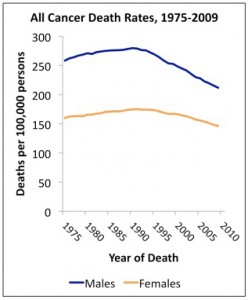
The Annual Report on Cancer Rates in the United States
-
In January 2012, the National Cancer Institute (NCI) released its annual report to the nation, which found a continuing decrease in deaths from cancer in men, women and children since the 1990s.

Cancer deaths have declined 20 percent since 1991, which means there were 1.2 million fewer deaths from cancer in 2009, according to the American Cancer Society.
These favorable trends were seen for all major racial and ethnic groups and are likely due to increased screening rates leading to earlier stage at diagnosis, and improvements in treatment.
Rates of new cases of cancer decreased for men in five common cancers:
- prostate
- lung
- colorectal
- stomach
- larynx
Among women, the rate of new cases of cancer decreased for seven cancers:
- lung
- colorectal
- bladder
- cervix
- head and neck
- ovary
- stomach

Changes in lifestyle factors, such as decreased smoking rates and healthier diets may account for some of these decreased rates.
Percent of adolescent girls who received 3 doses of HPV vaccine. (courtesy of the National Cancer Institute)
On a less favorable note, some cancers related to exposure to human papilloma virus (HPV), notably head and neck cancers, anal cancers, and vulvar cancers in women are on the rise. The report concludes that increased use of the HPV vaccine among adolescent boys and girls could eventually curb the increase in HPV-associated cancers.
Directions for future improvement include increasing access to early detection and treatment and programs that increase cancer prevention strategies at the population level.
NCI Report: Report to the Nation shows U.S. cancer death rates continue to drop; Special feature highlights trends in HPV-associated cancers and HPV vaccination coverage levels
